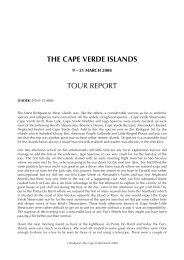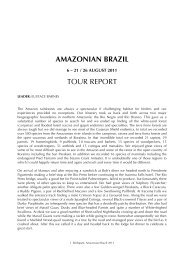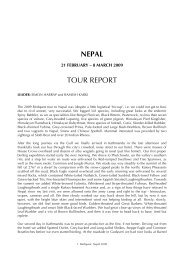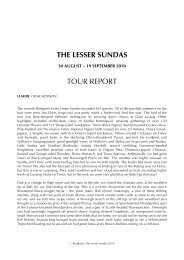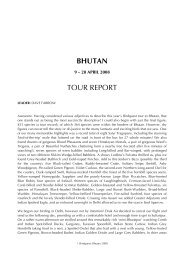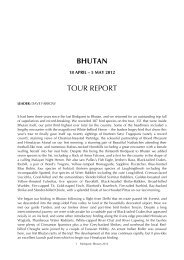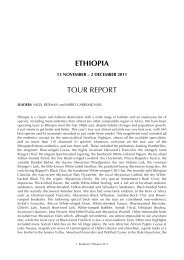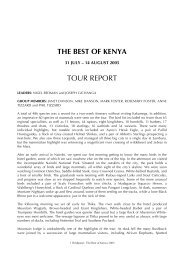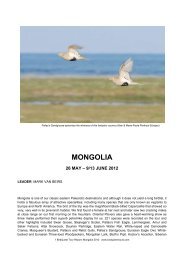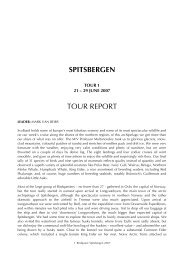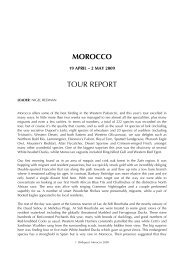Download Full Tour Report 1202kb - Birdquest
Download Full Tour Report 1202kb - Birdquest
Download Full Tour Report 1202kb - Birdquest
Create successful ePaper yourself
Turn your PDF publications into a flip-book with our unique Google optimized e-Paper software.
individual of Black-and-white Hawk-Eagle for the trip. The dainty Yellow-billed Tern was also a<br />
regular sight during the journey. Soon the massive Pantiacolla ridge appeared on the horizon and by<br />
late morning we had arrived at Pantiacolla Lodge where we would overnight. We wasted little time<br />
in heading out on the trails both before and after lunch and were well rewarded. The major highlight<br />
of today was our encounter with a family group of Pale-winged Trumpeters. We also enjoyed<br />
fabulous sightings of Striolated Puffbird, White-cheeked Tody-Flycatcher and Brown-rumped Foliagegleaner.<br />
Other highlights from today included Great Tinamou, Broad-billed Motmot, Scarlet-hooded<br />
Barbet, Rufous-headed Woodpecker (alas, only for some), Striated, Manu and White-lined Antbirds,<br />
and Short-tailed Pygmy-Tyrant.<br />
The next morning started off really well with a first-year Long-tailed Potoo on his call perch. After<br />
breakfast we visited a nearby clay-lick where we saw several Blue-headed Macaws perched in<br />
addition to a nice assortment of other parrots that included White-eyed Parakeet. An added bonus<br />
was our first Little Ground-Tyrant of the trip walking along the sandy river bank. Back on the lodge<br />
trails we all managed to catch up with a male Scarlet-hooded Barbet as only a few of us saw the one<br />
yesterday. This near-endemic is one of the more spectacular specialities of southeast Peru. It became<br />
immediately obvious as the morning progressed that a dreaded cold front or friaje had moved into the<br />
area dropping both the temperatures and the bird activity. These cold fronts move into the lowlands<br />
of south-eastern Peru when austral winter storms push north from southern South America. The forest<br />
was much more quiet today but we still managed to have good sightings of Ferruginous Pygmy-Owl,<br />
Lineated Woodpecker, Cabanis’s Spinetail, Olivaceous Woodcreeper, Plain-throated Antwren, and<br />
Large-headed and Dusky-tailed Flatbills. We also had an exciting (and smelly) encounter with a herd<br />
of at least 50 tooth-clacking White-lipped Peccary including a few large males. Then by late morning<br />
we continued downstream on the Rio Madre de Dios towards Boca Manu and the Manu River. The<br />
friaje made for a cold and wet journey today with most of us bundled up in our cold weather gear,<br />
not exactly the sort of temperatures you expect in the Amazon basin! We were all glad to reach the<br />
Manu park guard station by mid-afternoon where we signed in before continuing our journey up the<br />
Manu River to the newly opened Romero Rainforest Lodge inside Manu National Park. Some of the<br />
river birds seen during the journey included Horned Screamer, Bat Falcon, Pied Lapwing, Collared<br />
Plover and Black Skimmer. Everyone was delighted with the accommodation particularly with the<br />
gas-heated hot showers and we were eager to get into the surrounding forest given we were the first<br />
birders to ever stay there. Most participants had previously looked forward to birding inside the<br />
fabled Manu National Park for some time.<br />
Over the next two days we did a fairly thorough survey of the connecting trails between Romero and<br />
the Limonal ranger station walking around 8 kilometres each day sometimes more. However this<br />
distance was manageable thanks to the cool weather of the friaje. We made the most of being in the<br />
field each day by having our cook Aurelio together with our boat crew bring out a fine picnic lunch<br />
(hot!) to wherever we happened to be in the forest around midday. The forest was a mix of<br />
regenerated floodplain with some terra firme and bird diversity appeared to be quite high. One of our<br />
favourite sightings of the whole trip was from the lodge clearing where a male White-flanked<br />
Antwren sat on a low perch and shivered his wings in time with his song, marvellous! Further afield<br />
we saw some goodies in the upland bamboo stands which included Rufous-breasted Piculet, Redbilled<br />
Scythebill, Ihering’s Antwren, Long-crested Pygmy-Tyrant, White-cheeked Tody-Tyrant and<br />
Brown-rumped Foliage-gleaner. We tried our best to find the newly described Rufous Twistwing but<br />
despite our efforts it remains unknown from this particular forest. A Razor-billed Curassow was seen<br />
out on the river bank early one morning as we set off in our boat, and in general we were able to see<br />
a nice collection of Amazonian birds during our stay at Romero. Highlights included Bartlett’s<br />
Tinamou seen on more than one occasion, a superb close-perched Ornate Hawk-Eagle (thanks<br />
Martine!), a Banded Antbird on his understorey song perch, fairly common Casqued Oropendolas, a<br />
lovely pair of Scale-backed Antbirds, the oddly wonderful Musician Wren and a very cooperative<br />
Olive-backed Foliage-gleaner. We looked far and wide along the Romero trails for Black-faced<br />
Cotinga in suitable habitat but had nary a sniff probably due to the friaje. The cold temperatures of<br />
6 <strong>Birdquest</strong>: The Manu 20011




